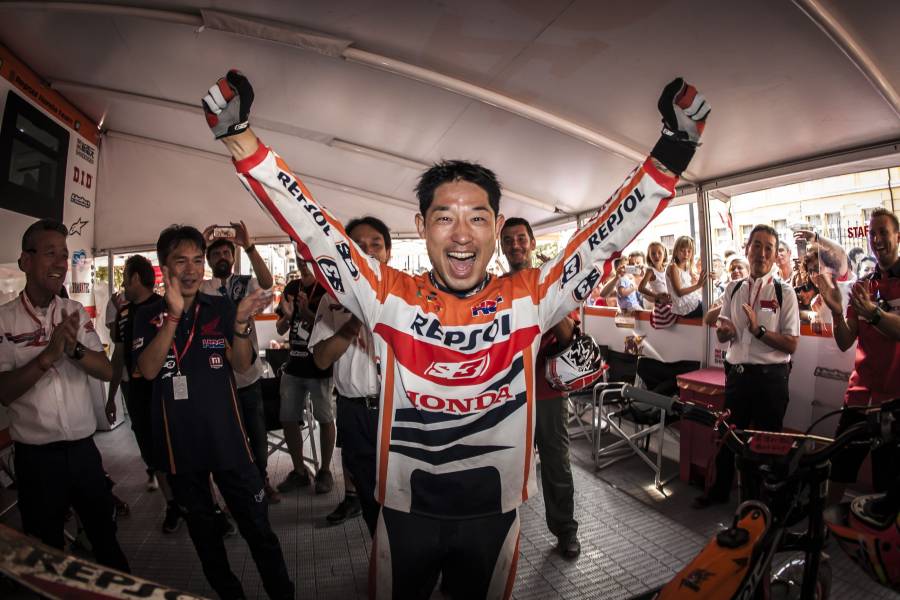26 years history of Takahisa Fujinami Part2 - Rivals and the fight against himself -
On September 19, 2021, Takahisa Fujinami announced his retirement from 26 years of world championship racing. This is the story of the only Japanese rider to become a champion in the Trial World Championship, covering 2005, the year after he became world champion, to 2013.

In 2005, not only did Fujinami’s bike number change to No. 1, but he would compete on the brand new COTA4RT (Honda RTL250F), just released to the market. The global movement towards cleaning up exhaust fumes led to trial bikes moving from 2- to 4-stroke engines. Leading the trend in the world championship were the three Repsol Honda Team riders, Takahisa Fujinami, Dougie Lampkin and Marc Freixa, on their all-new 4-stroke bikes.
1996, when Fujinami first entered the world championship, was the year that the COTA 315R (Honda RTL250R) prototype was completed, and development continued until 2004. Fujinami rode this bike from prototype to its final year. Final retail model specifications for the COTA 4RT (Honda RTL250F) were finalized during the 2004 season, and development of the race bikes that Fujinami and his teammates would ride began in earnest after the 2004 season had ended. A completely new bike, the change from 2- to 4-stroke engine, and the stress as the defending champion. Fujinami and his #1 bike had a completely new challenge ahead.
Newly-crowned Fujinami had the potential to defend his title. But, on a bike that had more maturing ahead of it, Fujinami had a difficult season. Many spectators wanted to see Fujinami defend his title, and Japanese fans looked forward to his triumphant return in the Japan trial. With such high expectations, Fujinami performs his best. The Japan trial is Fujinami’s lucky round. The crowd’s cheers at his every move give him more strength.

The 2005 and 2006 seasons were closely contended, but Fujinami finished second place in both years. Injuries and health concerns held Fujinami back from achieving his full potential, but even then, he was the only challenger to Adam Raga. Fujinami won seven rounds over the two year period.
2007 changed everything. Toni Bou arrived. Despite being new to the COTA 4RT, Bou won the indoor championship, and then virtually dominate the outdoor championship to win his second title in the same year. Fujinami, the team’s ace rider and more experienced in the world championship, was shocked. Winning the world championship requires more than outstanding technique. Depth coming with experience is also a prerequisite, which Fujinami had accrued over a long time. But Bou was the newly crowned champion on his first try. 2007 became the first year in seven that Fujinami did not win a single round.

Bou had become Fujinami’s teammate and fiercest rival. Fujinami trained hard, to beat Bou. In some areas, Fujinami had the upper hand. In others, Bou was superior. Fujinami learned what he could from Bou, and stole what techniques he could. This, however, led to Fujinami nearly losing his own riding style.
Without a win in 2007, Fujinami decided to stop chasing Bou’s style, but to enhance his own. Bou is Bou. Fujinami is Fujinami. In 2008, Fujinami scored his first win in two years. Since then, his world ranking stayed at Number 3 until 2011. For thirteen years since 1999, Fujinami has been ranked third or better in the world championship.

In such a long career, many young riders grow into challengers. To stay on top, these challengers need to be beaten. In 2012, Fujinami’s ranking fell to fifth, which he maintained until 2015. During that period he had been on the podium a number of times, and won the 2013 Japan trial. Winning a trial GP is definitely not easy. Out of the riders still competing, only Jeroni Fajardo, Albert Cabestany and Jaime Busto, apart from world champions such as Fujinami, have won a round. Fujigas was still going strong.
Off-season 2013 turned out to be a nightmare for Fujinami. He had torn an anterior cruciate ligament on his right knee during practice. Fujinami nonetheless was determined to overcome this career-ending injury, and continue trial competition. He would not be able to compete in the opening outdoor round if he had an operation off-season, so he opted to train to strengthen his muscles, protecting his ligaments. Eighteen years into his trial career, Fujinami believed in himself.